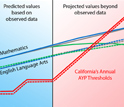|

Press Release 08-164
All Students Proficient on State Tests by 2014?

Analysis of California elementary school achievement data shows projected improvements in student performance will fall short of legislated benchmarks
September 25, 2008
The law known as No Child Left Behind (NCLB), enacted in 2002, set an ambitious goal: that across the nation, every state would test students annually in reading and math, and that the number of students scoring at the level of "proficient" or higher would rise each year, until all students reached proficiency in the year 2014. Towards that end, each state developed its own assessment tests and identified a rate of adequate yearly progress (AYP) towards full proficiency by 2014. Schools that do not meet AYP can face sanctions ranging from being identified as a school needing improvement to (after five years) being subject to corrective action and restructuring--even a complete reorganization or takeover of the school. One of the challenges of meeting AYP is that schools, districts and states must report not only a rise in total scores, but also progress in the scores of subgroups of students including minority students, English language learners (ELL) and students with disabilities. "The result is that the lowest-performing subgroup will ultimately determine the proficiency of a school, district or state," says Rich Cardullo, one of the authors of a paper published in the Sept. 26 issue of Science magazine, which analyzes testing data from California's elementary schools. Cardullo, who chairs the biology department at the University of California, Riverside (UCR), led a team of researchers in a study that projected California's ability to meet the 2014 proficiency goal. With funding from the National Science Foundation through the Math and Science Partnership (MSP) program, the researchers analyzed state assessment data from more than 4,900 elementary schools in the school years 2002-2003 through 2006-2007, then made projections of future proficiency scores using three different mathematical models. Even using the most optimistic model, the analysis found that nearly 100 percent of California elementary schools failed to meet AYP by 2014. In fact, average proficiency in English Language Arts fell short of AYP by the year 2011, and math proficiency fell short by 2012. With each state having been given the authority to determine its own path to proficiency, 22 other states have chosen the same path as California: to set a low rate of growth for the first few years, then raise the rate dramatically from 2008 to 2014. As shown in the chart at right, the projected performance of schools is on a collision course with the steep rise in California's annual AYP thresholds. "To use an analogy from the housing world, the balloon payment is about to hit," says Cardullo. Cardullo and his colleagues were led to do this work after a long history of working with schools. He notes that in California, "we have this incredibly rich data set, with all the diverse student populations that NCLB talks about. What is happening in California is possibly a good indicator of what is occurring in other states." In their analysis, the researchers looked at the distribution of schools in terms of the percentages of students meeting proficiency standards, rather than just the mean scores, to identify patterns in student performance. This allows for looking at the impact of factors such as teacher professional development, which is a focus of Cardullo's MSP project. "Most states--and the federal government--have been reporting gains in the state-wide percentage of students scoring proficient or advanced on standardized tests to suggest that accountability measures are effective at increasing student learning," Cardullo said. "What is being lost, however, is the information in the distributions. By focusing attention on average scores of the highest performing students we risk ignorance of the progress of the lowest performing students, potentially leaving behind those that were to be served by NCLB."
-NSF-

Media Contacts
Maria C. Zacharias, NSF (703) 292-8454 mzachari@nsf.gov
Iqbal Pittalwala, University of California, Riverside 951-827-6050 iqbal@ucr.edu
Program Contacts
James E. Hamos, NSF (703) 292-4687 jhamos@nsf.gov
Principal Investigators
Rich Cardullo, University of California, Riverside 951-827-5901 biochair@ucr.edu
Related Websites
Online material for study of California student achievement data: http://www.sciencemag.org/cgi/content/full/321/5897/1781/DCI

The National Science Foundation (NSF) is an independent federal agency that
supports fundamental research and education across all fields of science and
engineering, with an annual budget of $6.06 billion. NSF funds reach all 50
states through grants to over 1,900 universities and institutions. Each year,
NSF receives about 45,000 competitive requests for funding, and makes over
11,500 new funding awards. NSF also awards over $400 million in
professional and service contracts yearly.
 Get News Updates by Email Get News Updates by Email
Useful NSF Web Sites:
NSF Home Page: http://www.nsf.gov
NSF News: http://www.nsf.gov/news/
For the News Media: http://www.nsf.gov/news/newsroom.jsp
Science and Engineering Statistics: http://www.nsf.gov/statistics/
Awards Searches: http://www.nsf.gov/awardsearch/
| 



